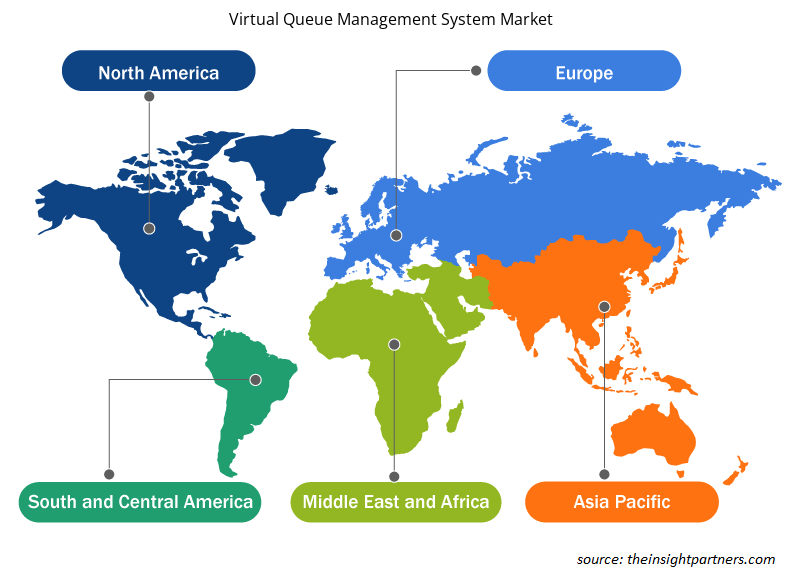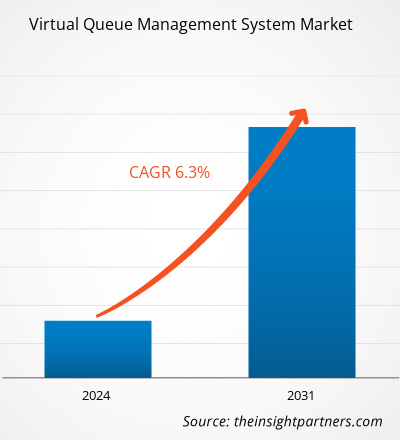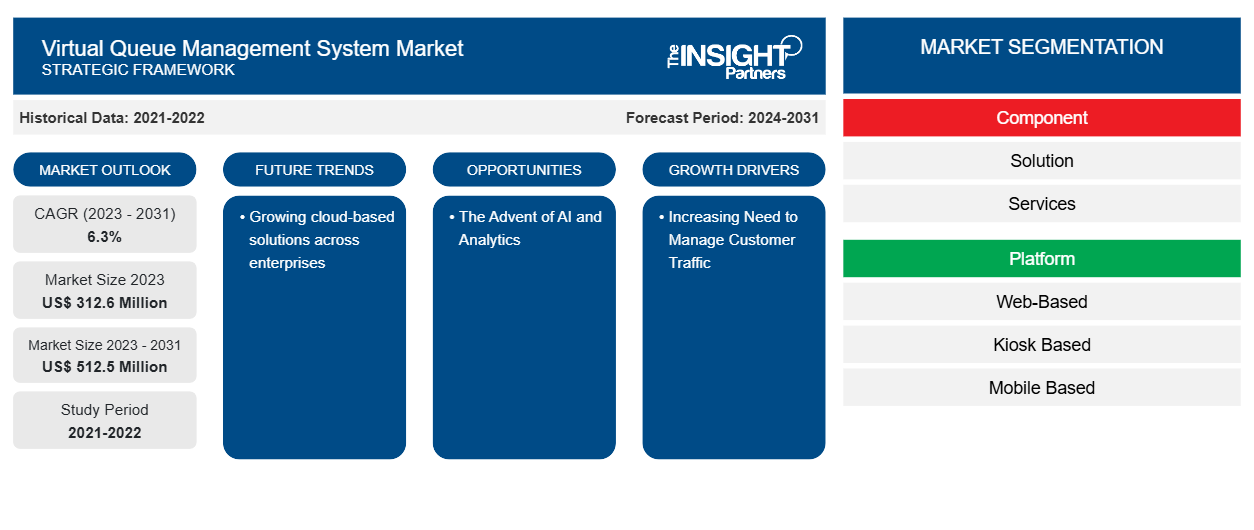من المتوقع أن يصل حجم سوق نظام إدارة الطوابير الافتراضية إلى 512.5 مليون دولار أمريكي بحلول عام 2031 من 312.6 مليون دولار أمريكي في عام 2023. ومن المتوقع أن يسجل السوق معدل نمو سنوي مركب بنسبة 6.3٪ خلال الفترة 2023-2031. ومن المرجح أن يظل نمو الحلول المستندة إلى السحابة عبر المؤسسات اتجاهًا رئيسيًا في السوق.
تحليل سوق نظام إدارة الطوابير الافتراضية
يمكن أن تؤدي إدارة الطوابير الافتراضية إلى زيادة رضا العملاء، وتبسيط الاتصالات، وتحسين تدفق العملاء، وتقصير أوقات الانتظار. كما يمكن للشركات التي تستخدم نظام الطوابير الافتراضية استيعاب المزيد من العملاء. توفر أنظمة الطوابير الافتراضية إدارة محسنة لحركة الركاب في المطار. يساعد هذا في تجنب الازدحام ويضمن انتقالات أفضل بين الأنشطة مثل تسجيل الوصول، والفحوص الأمنية، والصعود إلى الطائرة.
نظرة عامة على سوق نظام إدارة طوابير الانتظار الافتراضية
تعمل حلول الطوابير الافتراضية على تقليل أو القضاء على الطوابير المادية، مما يضمن للعملاء قضاء وقت أقل في الانتظار في الطوابير. توفر الطوابير الافتراضية تحديثات في الوقت الفعلي، مما يبقي العملاء على اطلاع بموقفهم ويعزز تجربتهم الإجمالية. يقلل حل إدارة الطوابير الافتراضية من تكاليف العمالة الإضافية ويضمن نشر الموارد بشكل فعال. كما تفيدك أنظمة إدارة الطوابير الافتراضية من خلال السماح لك بتوجيه العميل بذكاء إلى الطابور الصحيح بناءً على احتياجاته من الخدمة. إذا اختار العميل الطابور الخطأ عن طريق الخطأ، فيمكنك تغييره بسرعة لهم.
قم بتخصيص هذا التقرير ليناسب متطلباتك
ستحصل على تخصيص لأي تقرير - مجانًا - بما في ذلك أجزاء من هذا التقرير، أو تحليل على مستوى الدولة، وحزمة بيانات Excel، بالإضافة إلى الاستفادة من العروض والخصومات الرائعة للشركات الناشئة والجامعات
-
احصل على أهم اتجاهات السوق الرئيسية لهذا التقرير.ستتضمن هذه العينة المجانية تحليلاً للبيانات، بدءًا من اتجاهات السوق وحتى التقديرات والتوقعات.
محركات وفرص سوق نظام إدارة الطوابير الافتراضية
تزايد الحاجة إلى إدارة حركة العملاء لصالح السوق
إن مراقبة حركة المستهلكين أمر بالغ الأهمية لأداء أي عمل تجاري. يتتبع تحليل حركة المرور تصرفات وعادات العملاء مع تفسير معناها أيضًا. إن مراقبة حركة المستهلكين لها العديد من المزايا. من حيث الأمان، يمكن أن يساعد تتبع نشاط العملاء وتحديد الأقسام الأكثر زيارة في الموقع في منع تجاوز مناطق معينة. علاوة على ذلك، يمكن لمراقبة حركة المرور ضمان تأمين هذه المواقع وعدم وصول الأشخاص غير المناسبين إليها. يمكن استخدام مراقبة حركة المرور في مجموعة متنوعة من الشركات، بما في ذلك المؤسسات المالية ومتاجر البيع بالتجزئة والمستشفيات والمباني الحكومية والمباني المكتبية والحرم الجامعي والمستودعات وغير ذلك الكثير. تساعد مراقبة حركة المستهلكين أيضًا في ضمان عدم تأخير تجربة التسوق أو الدخول إلى منشأة آمنة بشكل غير ملائم بسبب الطوابير المفرطة. تمكن البيانات الناتجة عن أنشطة المراقبة أصحاب الأعمال من اكتساب فهم قوي للمناطق الأكثر شعبية، والتي يمكنهم استخدامها لصالحهم والتحضير بشكل مناسب. وبالتالي، فإن الحاجة المتزايدة لإدارة حركة العملاء، تدفع نمو السوق.
ظهور الذكاء الاصطناعي والتحليلات.
مع اعتماد تجار التجزئة بشكل متزايد لاستراتيجيات متعددة القنوات ، تلعب تقنيات إدارة طوابير الانتظار بالذكاء الاصطناعي دورًا مهمًا في ربط التفاعلات عبر الإنترنت والتفاعلات المادية. يمكن للعملاء استخدام تطبيق المتجر لمعرفة أطوال طوابير الانتظار في الوقت الفعلي، مما يسمح لهم بتحديد ما إذا كانوا سيحضرون أو يحجزون موعدًا لتجنب الانتظار. يزيد هذا التكامل السلس من سعادة المستهلك وولائه. علاوة على ذلك، يمكن استخدام الذكاء الاصطناعي لتقدير أوقات انتظار المستهلك في الطابور. قد يرى العملاء المدة التي سيضطرون إلى انتظارها للحصول على الخدمة في الوقت الفعلي. يتيح هذا للعملاء التخطيط لرحلاتهم وتجنب الطوابير المفرطة، وربما يقررون العودة لاحقًا عندما يكون المكان أقل ازدحامًا. إذا تم توفير هذه المعلومات عبر الإنترنت، فيمكنهم اختيار الوصول عندما يكون الانتظار في أقصر وقت. سيفيد هذا أيضًا العمل من خلال تسهيل الطلب والاستفادة بشكل أفضل من الموارد. يمكن للذكاء الاصطناعي المساعدة في تحديد أولويات العملاء في الانتظار. وهذا يعني أن العملاء الذين لديهم مطالب عاجلة، مثل أولئك الذين يحتاجون إلى إيداع بنكي في وقت محدد أو الذين يتأخرون عن رحلتهم، قد يتم تقديم الخدمة لهم قبل أولئك الذين لديهم احتياجات أقل إلحاحًا. يمكن أن يساعد هذا في ضمان عدم تعرض أي شخص لنتيجة سيئة وعدم إمكانية تقديم المساعدة له.
تقرير تحليلي لتجزئة سوق نظام إدارة طوابير الانتظار الافتراضية
إن القطاعات الرئيسية التي ساهمت في اشتقاق تحليل سوق نظام إدارة طوابير الانتظار الافتراضية هي المكون والمنصة والمستخدم النهائي.
- استنادًا إلى المكونات، يتم تقسيم سوق نظام إدارة قائمة الانتظار الافتراضية إلى حلول وخدمات.
- بحسب المنصة، يتم تقسيم السوق إلى منصة تعتمد على الويب، ومنصة تعتمد على الأكشاك، ومنصة تعتمد على الهاتف المحمول.
- بحسب حجم المنظمة، يتم تقسيم السوق إلى مؤسسات صغيرة ومتوسطة ومؤسسات كبيرة.
- من حيث المستخدمين النهائيين، يتم تقسيم السوق إلى تجارة التجزئة والمستشفيات والعيادات والمطارات والمتاحف والمكتبات وغيرها.
تحليل حصة سوق نظام إدارة طوابير الانتظار الافتراضية حسب المنطقة الجغرافية
ينقسم النطاق الجغرافي لتقرير سوق نظام إدارة الطابور الافتراضي بشكل أساسي إلى خمس مناطق: أمريكا الشمالية، ومنطقة آسيا والمحيط الهادئ، وأوروبا، والشرق الأوسط وأفريقيا، وأمريكا الجنوبية والوسطى. أمريكا الشمالية هي منطقة متقدمة من الناحية التكنولوجية. تعتمد المنطقة بشكل متزايد على حلول رقمية مختلفة. علاوة على ذلك، فإن وجود شركات تكنولوجيا المعلومات العملاقة يدفع نمو السوق. يغير إجراء الطابور الافتراضي بشكل أساسي كيفية انتظار الأفراد في الطابور، مما يزيد بشكل كبير من تجربة المستهلك. يمكن للعملاء تسجيل الوصول من أي مكان على هواتفهم، وعرض أوقات الانتظار، والاتصال بأعضاء الخدمة دون الحاجة إلى المشاركة شخصيًا، مما أدى إلى نمو اعتماد إدارة الطابور الافتراضية.
رؤى إقليمية حول سوق نظام إدارة طوابير الانتظار الافتراضية
لقد قام المحللون في Insight Partners بشرح الاتجاهات والعوامل الإقليمية المؤثرة على سوق نظام إدارة الطوابير الافتراضية طوال فترة التوقعات بشكل شامل. يناقش هذا القسم أيضًا قطاعات سوق نظام إدارة الطوابير الافتراضية والجغرافيا في جميع أنحاء أمريكا الشمالية وأوروبا ومنطقة آسيا والمحيط الهادئ والشرق الأوسط وأفريقيا وأمريكا الجنوبية والوسطى.

- احصل على البيانات الإقليمية المحددة لسوق نظام إدارة قائمة الانتظار الافتراضية
نطاق تقرير سوق نظام إدارة الطوابير الافتراضية
| سمة التقرير | تفاصيل |
|---|---|
| حجم السوق في عام 2023 | 312.6 مليون دولار أمريكي |
| حجم السوق بحلول عام 2031 | 512.5 مليون دولار أمريكي |
| معدل النمو السنوي المركب العالمي (2023 - 2031) | 6.3% |
| البيانات التاريخية | 2021-2022 |
| فترة التنبؤ | 2024-2031 |
| القطاعات المغطاة |
حسب المكون
|
| المناطق والدول المغطاة |
أمريكا الشمالية
|
| قادة السوق وملفات تعريف الشركات الرئيسية |
|
كثافة اللاعبين في سوق نظام إدارة الطوابير الافتراضية: فهم تأثيرها على ديناميكيات الأعمال
يشهد سوق أنظمة إدارة الطوابير الافتراضية نموًا سريعًا، مدفوعًا بالطلب المتزايد من المستخدم النهائي بسبب عوامل مثل تفضيلات المستهلكين المتطورة والتقدم التكنولوجي والوعي المتزايد بفوائد المنتج. ومع ارتفاع الطلب، تعمل الشركات على توسيع عروضها والابتكار لتلبية احتياجات المستهلكين والاستفادة من الاتجاهات الناشئة، مما يؤدي إلى زيادة نمو السوق.
تشير كثافة اللاعبين في السوق إلى توزيع الشركات أو المؤسسات العاملة في سوق أو صناعة معينة. وهي تشير إلى عدد المنافسين (اللاعبين في السوق) الموجودين في مساحة سوق معينة نسبة إلى حجمها أو قيمتها السوقية الإجمالية.
الشركات الرئيسية العاملة في سوق نظام إدارة قائمة الانتظار الافتراضية هي:
- مجموعة أكسيس للتكنولوجيا، شركة عامة محدودة
- شركة ادفانتيش المحدودة
- تقنيات أكيس
- حلول تقنية المعلومات إيجلوب
- صناعات لافي
- أومبوري
إخلاء المسؤولية : الشركات المذكورة أعلاه ليست مرتبة بأي ترتيب معين.

- احصل على نظرة عامة على أهم اللاعبين الرئيسيين في سوق نظام إدارة قائمة الانتظار الافتراضية
أخبار السوق والتطورات الأخيرة لنظام إدارة الطوابير الافتراضية
يتم تقييم سوق نظام إدارة الطوابير الافتراضية من خلال جمع البيانات النوعية والكمية بعد البحث الأولي والثانوي، والتي تتضمن منشورات الشركات المهمة وبيانات الجمعيات وقواعد البيانات. فيما يلي بعض التطورات في سوق نظام إدارة الطوابير الافتراضية:
- أعلنت شركة Qtrac by Lavi Industries، المزود لأنظمة إدارة طوابير الانتظار وجدولة المواعيد الافتراضية، اليوم عن توفر منصة Qtrac NextGen. توفر أحدث نسخة من نظام إدارة طوابير الانتظار من Qtrac للمؤسسات منصة مؤسسية محسنة قابلة للتطوير وآمنة وشاملة. إنها تولد مصادر دخل جديدة من خلال الجمع بين معلومات الأعمال القوية ومهارات التسويق الرقمي، مما يسمح للشركات بتحسين تجربة العملاء مع زيادة مشاركة الموظفين وإنتاجيتهم. (المصدر: Qtrac، نوفمبر 2021)
- أطلقت شركة مونتا نظامًا للصفوف الافتراضية لشحن المركبات الكهربائية. تتيح وظيفة "الصفوف الذكية" الجديدة للسائقين الانضمام إلى صفوف افتراضية في محطة شحن واحدة أو أكثر وتلقي إشعارات سريعة عند توفر نقطة شحن، لتقليل احتمالية نفاد طاقة المركبات عند السفر لمسافات طويلة. (المصدر: مونتا، أكتوبر 2021)
تقرير سوق نظام إدارة الطوابير الافتراضية: التغطية والنتائج المتوقعة
يوفر تقرير "حجم سوق نظام إدارة طوابير الانتظار الافتراضية والتوقعات (2021-2031)" تحليلاً مفصلاً للسوق يغطي المجالات التالية:
- حجم سوق نظام إدارة الطوابير الافتراضية وتوقعاته على المستويات العالمية والإقليمية والوطنية لجميع قطاعات السوق الرئيسية التي يغطيها النطاق
- اتجاهات سوق نظام إدارة الطوابير الافتراضية بالإضافة إلى ديناميكيات السوق مثل المحركات والقيود والفرص الرئيسية
- تحليل مفصل لقوى PEST/Porter الخمس وSWOT
- تحليل سوق نظام إدارة الطوابير الافتراضية الذي يغطي اتجاهات السوق الرئيسية والإطار العالمي والإقليمي واللاعبين الرئيسيين واللوائح والتطورات الأخيرة في السوق
- تحليل المشهد الصناعي والمنافسة الذي يغطي تركيز السوق، وتحليل خريطة الحرارة، واللاعبين البارزين، والتطورات الأخيرة لسوق نظام إدارة قائمة الانتظار الافتراضية
- ملفات تعريف الشركة التفصيلية
- التحليل التاريخي (سنتان)، سنة الأساس، التوقعات (7 سنوات) مع معدل النمو السنوي المركب
- تحليل PEST و SWOT
- حجم السوق والقيمة / الحجم - عالمي، إقليمي، بلد
- الصناعة والمنافسة
- مجموعة بيانات إكسل
التقارير الحديثة
تقارير ذات صلة
شهادات العملاء
سبب الشراء
- اتخاذ قرارات مدروسة
- فهم ديناميكيات السوق
- تحليل المنافسة
- رؤى العملاء
- توقعات السوق
- تخفيف المخاطر
- التخطيط الاستراتيجي
- مبررات الاستثمار
- تحديد الأسواق الناشئة
- تحسين استراتيجيات التسويق
- تعزيز الكفاءة التشغيلية
- مواكبة التوجهات التنظيمية























 احصل على عينة مجانية ل - سوق نظام إدارة طوابير الانتظار الافتراضية
احصل على عينة مجانية ل - سوق نظام إدارة طوابير الانتظار الافتراضية